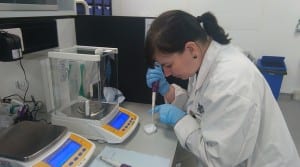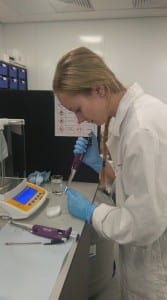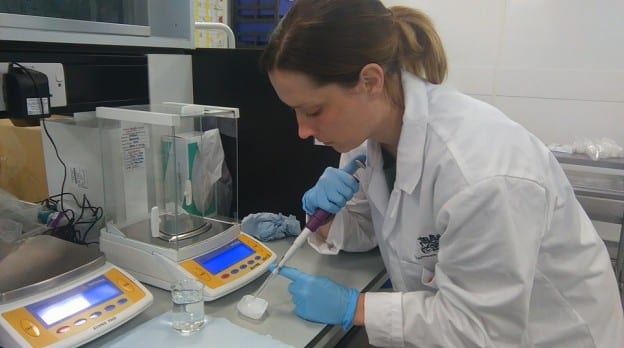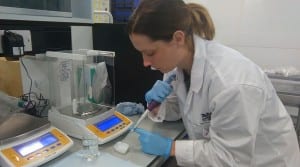Accuracy and reproducibility are of central importance in laboratory science, and you need to be sure your pipetting skills are as reliable as possible. Dr. Bates felt this was an important lesson the group needed to learn before we embarked on any experiments. We used a 100 – 1000μl (P1000) pipette as a starting point. 1μl=0.001ml.

Sam working on her pipetting skills
The first step was to understand the importance of ensuring your body and arms are in the correct ergonomic and comfortable position. If this is not the case, then it can affect your technique and ability to pipette accurately and reproducibly over a length of time. The next step was how to hold your pipette, ensuring the pipette was fully supported with your (pipetting) elbow on the table to reduce any shaking
The final step was to regulate the speed at which the liquid is aspirated and dispensed; too fast and inaccuracies could happen, too slow and you would be there a long time.
Once the group felt confident they had grasped the technique, we moved onto testing ourselves. Using the analytical balance we pipetted 1000μl into a pre-weighed Eppendorf tube or weighing boat; this proved very interesting as we could compare our accuracy and reproducibility. Overall, with the P1000 pipette, the group obtained an average of 0.045% accuracy, which is less than 0.5μl in 1000μl. Dr. Bates said this was “outstandingly good” and showed that we had used and implemented his advice, developing our technique to the level at which “it could be used and accepted” in a Good Laboratory Practise (GLP) and International Standards Organisation (ISO) environment, such as is used in leading pharmaceutical companies such as GlaxoSmithKline or Pfizer.
Our next task was to use the 20 – 200μl pipette, which would be slightly more challenging. Again (as demonstrated by Dr. Bates) we each pipetted a 100μl volume into 10 pre-weighed tubes and weighed the resultant tube with water inside to work out our accuracy and reproducibility scores. The group obtained an average of 0.16% accuracy, which Dr. Bates again said was “excellent” as this equates to only a difference of only 0.16μl in 100μl, a figure that would also be accepted in an industrial GLP/ISO environment.

Corinne taking her time to ensure accuracy.
Following instructions by the technicians Angela Murtagh and Beverly Shepherd, the group also had an opportunity to learn how to dismantle and clean their pipettes, as equipment can be expensive and so looking after it and understanding how it works is important.
This pipetting training proved very useful and will be something we will be able to use for the remainder of our degrees and future scientific careers.

